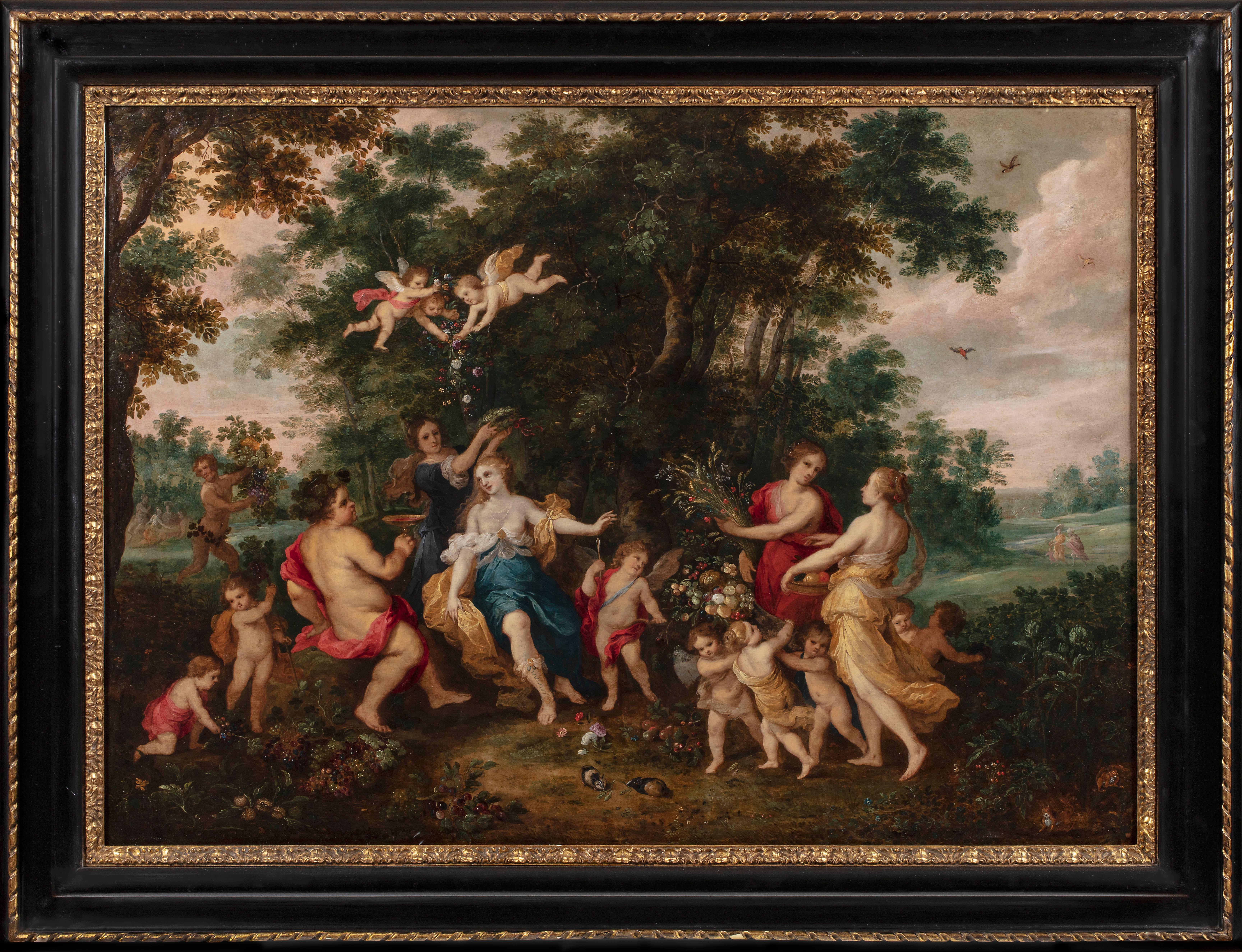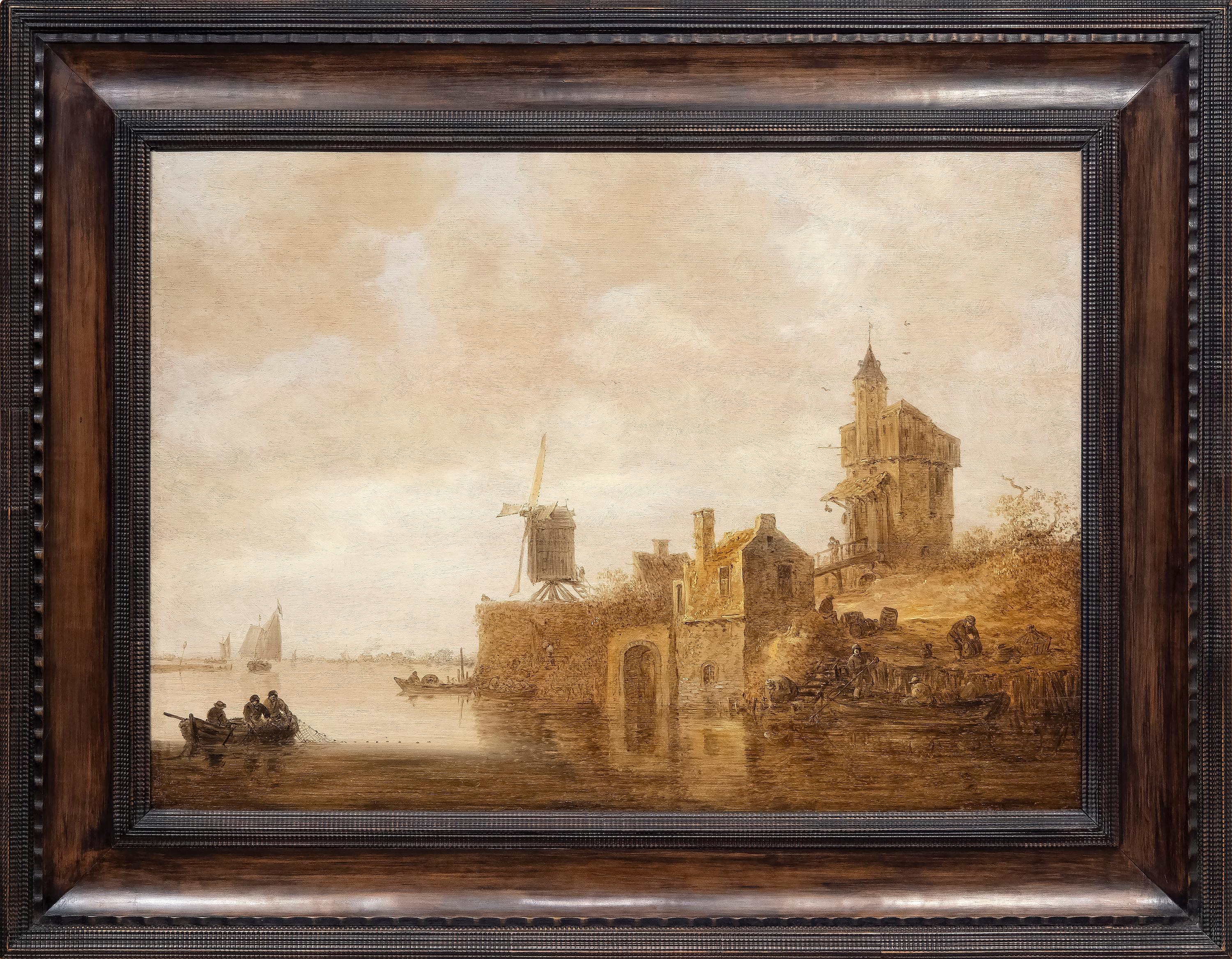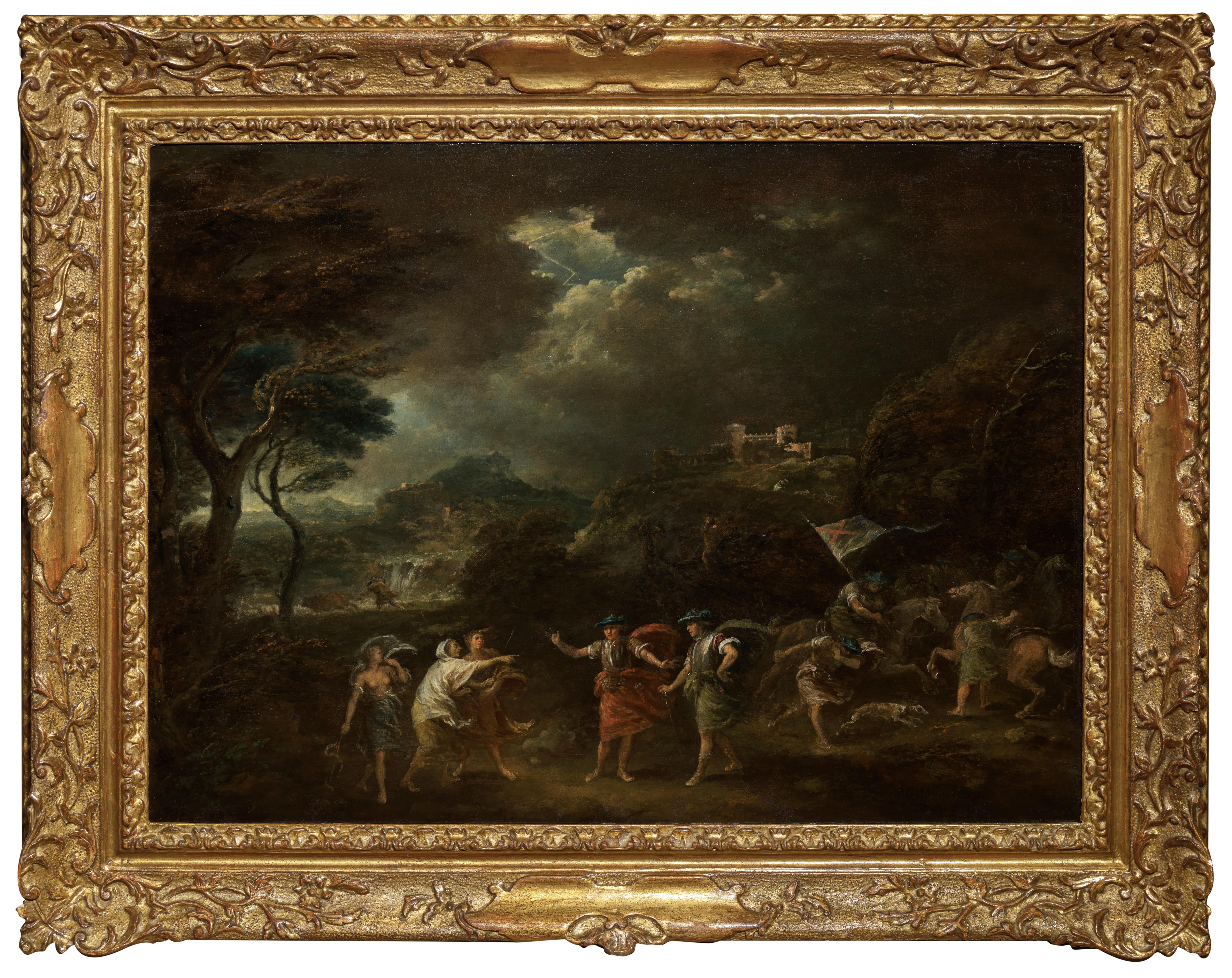Items Similar to 18th Century Lanscape Oil Painting of Matlock High-Torr
Want more images or videos?
Request additional images or videos from the seller
Thomas Smith (b.1720)18th Century Lanscape Oil Painting of Matlock High-Torrcirca 1750
circa 1750
About the Item
Thomas Smith of Derby
Matlock High-Torr Landscape
Oil on canvas
27 x 34.5 inches unframed
34 x 41.5 inches including frame
Thomas Smith of Derby (died 12 September 1767) was an English landscape painter famed for his paintings and engravings of historic houses and views of the Lake District. Though few paintings of the artist survive to this day, his engravings have been preserved in renowned collections including the Royal Academy, the British Museum, and the Yale Museum. He is a pivotal figure in the genesis of the English picturesque. His series of ‘Eight of the most extraordinary Natural Prospects in the Mountainous Part of Derbyshire and Straffordshire, commonly called the Peak’ are the earliest prints to depict features of the English countryside as pure landscape in its own right. His landscape of Matlock High-Torr continues to build upon this tradition. The Peak district attracted many tourists in the mid-eighteenth century, who journeyed to see the severe landscapes encapsulated so beautifully by Thomas Smith of Derby. That by 1751 Smith had published a total of fifty large prints of English topographical scenes attests to the popularity of this genre. This oil painting by the artist is a rare relic of Smith working in the medium, and brings to life the melancholic landscape of Matlock High-Torr, which he also recorded as an engraving.
- Creator:Thomas Smith (b.1720) (1720 - 1767)
- Creation Year:circa 1750
- Dimensions:Height: 34 in (86.36 cm)Width: 41.5 in (105.41 cm)
- Medium:
- Movement & Style:
- Period:
- Condition:
- Gallery Location:London, GB
- Reference Number:1stDibs: LU67334507571
About the Seller
5.0
Vetted Seller
These experienced sellers undergo a comprehensive evaluation by our team of in-house experts.
Established in 1990
1stDibs seller since 2017
40 sales on 1stDibs
Typical response time: 1 to 2 days
- ShippingRetrieving quote...Ships From: London, United Kingdom
- Return PolicyA return for this item may be initiated within 1 day of delivery.
More From This SellerView All
- Grand 19th Century English Marine Painting in Stunning LightBy John Wilson EwbankLocated in London, GBJohn Wilson Ewbank (1799 - 1847) Shipping in the Harbour, South Shields Oil on canvas 39.5 x 58 inches unframed 47.75 x 66.5 inches framed Provenance: Christie's October 2002; Lot 11. Fine Art Society; Private Collection This marvellous up to scale Ewbank is full of light and warmth and almost certainly his greatest work of the sort rarely - if ever - seen on the market. John W. Ewbank (4 May 1799–28 November 1847), was an English-born landscape and marine painter largely operational from Scotland. The Humber river is a large tidal estuary on the east coast of Northern England. Life Ewbank was born at Darlington on 4 May 1799, the son of Michael Ewbank, an innkeeper. He was adopted as a child by a wealthy uncle who lived at Wycliffe, on the banks of the River Tees, in the North Riding of Yorkshire. Intended for the Roman Catholic priesthood, he was sent to Ushaw College, from which he absconded. In 1813 Ewbank was apprenticed to Thomas Coulson, an ornamental painter in Newcastle. In around 1816 he moved with Coulson to Edinburgh, where he had some lessons with Alexander Nasmyth. He found work both as a painter and a teacher. He was nominated in 1830 one of the foundation members of the Royal Scottish Academy. In 1833 he is listed as living at 7 Union Street on the eastern fringe of the New Town in Edinburgh. Works His sketches from nature were especially admired, and a series of 51 drawings of Edinburgh by him were engraved by W. H. Lizars for James Browne's Picturesque Views of Edinburgh (1825). He also made a reputation with cabinet pictures of banks of rivers, coast scenes, and marine subjects. As an illustrator he illustrated some early editions of Scott's Waverley Novels and one edition of Gilbert White...Category
19th Century Old Masters Figurative Paintings
MaterialsOil
- 18th Century Neoclassical Oil Painting of the Trojan War: Briseis & AchillesBy James ThornhillLocated in London, GBJames Thornhill (1674-1735) Oil on canvas 12 x 14 inches; 16 ½ x 18 ½ in. Inc. frame The subject matter and inclusion of herms on both sides shows the influence of Louis...Category
Early 18th Century Old Masters Figurative Paintings
MaterialsOil, Canvas
- A Beautiful and Large Marine - A Ship in Two Positions Off DoverBy William John HugginsLocated in London, GBWilliam John Huggins (1781-1845) A Ship in Two Positions Off Dover oil on canvas Unsigned 33 x 45 inches, inc. frame William John Huggins, of wh...Category
19th Century Old Masters Figurative Paintings
MaterialsOil
- 17th Century Classical Oil Painting - Diana With Her Attendants in a GrottoBy Abraham van CuylenborchLocated in London, GBAbraham van CUYLENBROCH (1620-1658) Diana With Her Attendants in a Grotto 1651 signed oil on panel 12.2 in x 15.7 inches, inc. frame; 31 x 40 cm Provenance: Sale of Sotheby's Lo...Category
17th Century Old Masters Figurative Paintings
MaterialsOil
- Oil Painting of Landscape with 'The Papal Palace at Avignon'By Pieter BoutLocated in London, GBProvenance: Sotheby’s December 5th 2006, Lot 388 Bout was a Flemish painter, draughtsman and etcher. He is known mainly for his landscapes, city, coast and country views and archite...Category
Early 18th Century Old Masters Landscape Paintings
MaterialsOil
- 19th Century Oil painting of horses - Mares and Foals in a LandscapeBy Daniel ClowesLocated in London, GBDaniel CLOWES (1774-1829) after George Stubbs Mares and Foals in a Landscape oil on canvas 29 x 33 inches, inc.frame Daniel Clowes lived and worked in Chester all his life and ...Category
19th Century Old Masters Animal Paintings
MaterialsOil
You May Also Like
- Important 18th Century Royal Academy Old Master Oil Painting of Georgian LondonLocated in Gerrards Cross, GB‘St. James’ Day’ by Richard Morton Paye (1750-1820). This very large and important 18th century oil on canvas depicts a diverse crowd of Londoners at an oyster stand on a summer’s ev...Category
1780s Old Masters Figurative Paintings
MaterialsOil
- Allegory of AbundanceLocated in New York, NYPainted in collaboration with Hendrick van Balen (Antwerp, 1575 – 1632). Provenance: Private Collection, Uruguay, since the 1930s. The eldest son of Jan Br...Category
17th Century Old Masters Paintings
MaterialsCopper
- A WolfLocated in New York, NYProvenance: The Marchesi Strozzi, Palazzo Strozzi, Florence Sale, Christie’s, London, May 20, 1993, lot 315, as by Carl Borromaus Andreas Ruthart...Category
17th Century Old Masters Animal Paintings
MaterialsPaper, Canvas, Oil
- River Landscape with a Windmill and ChapelBy Jan Josefsz Van GoyenLocated in Palm Desert, CA"River Landscape with a Windmill and Chapel" is a painting by Dutch Old Master Painter, Jan van Goyen. There are traces of a signature on the bow of the boat...Category
1640s Old Masters Landscape Paintings
MaterialsPanel, Oil
- Macbeth and the Three Witches a Painting on Panel by Francesco ZuccarelliBy Francesco ZuccarelliLocated in PARIS, FRThis painting, created during Zuccarelli's stay in England, represents the decisive moment when Macbeth, together with Banquo, meets the three witches who announce that he will be Ki...Category
1760s Old Masters Landscape Paintings
MaterialsOil, Wood Panel
- Early oil depicting the Great Fire of LondonLocated in London, GBThe Great Fire of London in September 1666 was one of the greatest disasters in the city’s history. The City, with its wooden houses crowded together in narrow streets, was a natural fire risk, and predictions that London would burn down became a shocking reality. The fire began in a bakery in Pudding Lane, an area near the Thames teeming with warehouses and shops full of flammable materials, such as timber, oil, coal, pitch and turpentine. Inevitably the fire spread rapidly from this area into the City. Our painting depicts the impact of the fire on those who were caught in it and creates a very dramatic impression of what the fire was like. Closer inspection reveals a scene of chaos and panic with people running out of the gates. It shows Cripplegate in the north of the City, with St Giles without Cripplegate to its left, in flames (on the site of the present day Barbican). The painting probably represents the fire on the night of Tuesday 4 September, when four-fifths of the City was burning at once, including St Paul's Cathedral. Old St Paul’s can be seen to the right of the canvas, the medieval church with its thick stone walls, was considered a place of safety, but the building was covered in wooden scaffolding as it was in the midst of being restored by the then little known architect, Christopher Wren and caught fire. Our painting seems to depict a specific moment on the Tuesday night when the lead on St Paul’s caught fire and, as the diarist John Evelyn described: ‘the stones of Paul’s flew like grenades, the melting lead running down the streets in a stream and the very pavements glowing with the firey redness, so as no horse, nor man, was able to tread on them.’ Although the loss of life was minimal, some accounts record only sixteen perished, the magnitude of the property loss was shocking – some four hundred and thirty acres, about eighty per cent of the City proper was destroyed, including over thirteen thousand houses, eighty-nine churches, and fifty-two Guild Halls. Thousands were homeless and financially ruined. The Great Fire, and the subsequent fire of 1676, which destroyed over six hundred houses south of the Thames, changed the appearance of London forever. The one constructive outcome of the Great Fire was that the plague, which had devastated the population of London since 1665, diminished greatly, due to the mass death of the plague-carrying rats in the blaze. The fire was widely reported in eyewitness accounts, newspapers, letters and diaries. Samuel Pepys recorded climbing the steeple of Barking Church from which he viewed the destroyed City: ‘the saddest sight of desolation that I ever saw.’ There was an official enquiry into the causes of the fire, petitions to the King and Lord Mayor to rebuild, new legislation and building Acts. Naturally, the fire became a dramatic and extremely popular subject for painters and engravers. A group of works relatively closely related to the present picture have been traditionally ascribed to Jan Griffier...Category
17th Century Old Masters Landscape Paintings
MaterialsCanvas, Oil
Recently Viewed
View AllMore Ways To Browse
Large 18th Century Painting
18th Century English Painting
Old English 18th Century
B 34
Large 18th Oil
Prints Of 18th Century Paintings
British Genre Paintings
Old English Oil Paintings
Old Master Landscape Painting Large
Large Old Master Landscape
18th Century Oil Paintings Large
Old Antique Records
Large Mid Century Oil Painting Landscape
Large 18th Century Landscape
Large English Landscape Oil Painting
Large English Oil Paintings Of Landscapes
Mid Century Countryside Oil Painting
The Lake District




